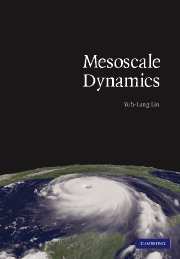Book contents
- Frontmatter
- Contents
- Preface
- 1 Overview
- 2 Governing equations for mesoscale motions
- 3 Basic wave dynamics
- 4 Mesoscale wave generation and maintenance
- 5 Orographically forced flows
- 6 Thermally forced flows
- 7 Mesoscale instabilities
- 8 Isolated convective storms
- 9 Mesoscale convective systems
- 10 Dynamics of fronts and jet streaks
- 11 Dynamics of orographic precipitation
- 12 Basic numerical methods
- 13 Numerical modeling of geophysical fluid systems
- 14 Parameterizations of physical processes
- Appendices
- Index
- References
12 - Basic numerical methods
Published online by Cambridge University Press: 15 December 2009
- Frontmatter
- Contents
- Preface
- 1 Overview
- 2 Governing equations for mesoscale motions
- 3 Basic wave dynamics
- 4 Mesoscale wave generation and maintenance
- 5 Orographically forced flows
- 6 Thermally forced flows
- 7 Mesoscale instabilities
- 8 Isolated convective storms
- 9 Mesoscale convective systems
- 10 Dynamics of fronts and jet streaks
- 11 Dynamics of orographic precipitation
- 12 Basic numerical methods
- 13 Numerical modeling of geophysical fluid systems
- 14 Parameterizations of physical processes
- Appendices
- Index
- References
Summary
Introduction
In Chapter 2, we derived a set of nonlinear partial differential equations governing mesoscale atmospheric motions. One way to study the dynamics associated with these equations is to make the small-amplitude approximations and solve the linearized equations analytically, as demonstrated in earlier chapters. However, this approach limits us to study only mesoscale systems with small-amplitude perturbations. In addition, the number of available analytical methods at hand to solve these complicated equations is limited. As mentioned in earlier chapters, an alternative solution is to use numerical methods where the equations are discretized and solved numerically in space and time. The advantage of applying the numerical methods is that they are able to solve completely the nonlinear set of equations. Numerical methods also provide a powerful framework for sensitivity tests or experiments with forcing or physical processes. In these experiments, physical parameterizations or external forcing can be easily altered or completely deactivated. Examples of the parameterizations include those for planetary boundary layer processes, moist processes, and radiative processes, while external forcing can come from orography. In this regard, numerical simulations are more flexible than physical experiments, such as experiments conducted in a water tank, gas chamber or wind tunnel, and field experiments conducted in the real atmosphere.
When numerical methods are adopted to solve mathematically intractable governing equations, one needs to address the following important questions: (1) Does the solution of the approximate equations converge to that of the original differential equations when the time and grid intervals approach zero?
- Type
- Chapter
- Information
- Mesoscale Dynamics , pp. 489 - 517Publisher: Cambridge University PressPrint publication year: 2007



